By Kelly Galfand, JOY IN YOUR SPACE, 610-896-6896
My role as organizer usually involves helping people:
• live with less
• have more within easy reach
• love what they store.
One popular area I organize is wardrobe closets. Sometimes I’m hired to fix a physical problem; I solve storage challenges. Sometimes I am the necessary support as someone decides:
• what to keep
• where to donate or sell
• how to let clothes go.

In my experience, even when someone commits to trimming their wardrobe, there is one item they want to get rid of but (in their words) “can’t!” In these situations, what’s really behind their “can’t” is guilt.
When I hear a closet client say “I can’t get rid of this,” I know the clothing in question was either expensive, a gift, or it holds sentimental value.
• If the item was expensive… and they haven’t worn it (ever or enough), the struggle is about throwing good money away. But honestly, they’re wasting more money by storing this item. Waiting too long to resell something is not smart; the resale market pays more for recent purchases.
• Check out resale avenues like TheRealReal, PoshMark, Clothes Mentor, Plato’s Closet, and ThredUp depending on the item’s value.
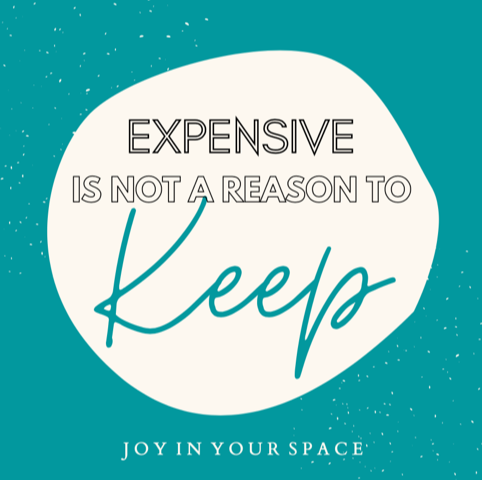
• If the item was a gift… from someone they love, their love for the person is getting in the way of their ability to decide what they want in their life. They sometimes think that letting the item go is akin to rejecting the gift-giver’s love, kindness, or generosity. Trust me, your favorite aunt knows you love her even if you don’t love the winter hat she gave you. I always reassure clients that no one gives a gift in order to burden the recipient. A recipient’s only responsibility is to be gracious in accepting the gift.
• —You can always donate the item or its value to a charitable organization the gift-giver supports to lessen the pain of letting the item go from your life. Let it be a gift that keeps on giving — to someone else!

• If the item holds memories it will fall into one of two categories:
• Clothing from the person’s own life (even if it was someone else’s at some point)
When I come across these sentimental clothes, the first question I ask is: Will you still wear it? If the answer is “yes,” it can stay.
If the answer is “no,” then I suggest the t-shirt, wedding gown, or cheerleading skirt move to a spot more suitable to memories and nostalgia.
• Clothing that holds memories may have belonged to a deceased loved one. I help people navigate these sensitive areas often. What I counsel, is to keep only the sweatshirts, t-shirts, or hats that meant something to the departed and mean something still to you if you have room for it.
If it’s something you aren’t going to wear, display it to honor it in some way. Shadow boxes are wonderful conversation pieces and visual reminders of our ancestors’ legacies.
To me, your adored Uncle’s memory does not hinge on a single t-shirt…not even on his entire t-shirt collection. I recommend that if you let items go from your life (that belonged to someone you loved) decide how you will remember this person (in thought or deed) once you let the item go. Then be intentional in keeping their memory alive.
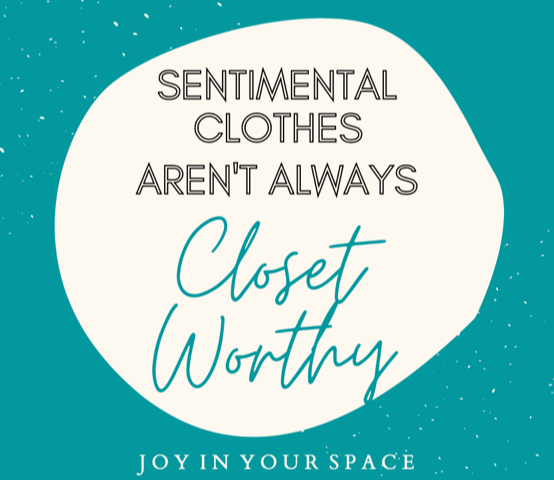
In 2015 Forbes reported a Bureau of Labor statistic affirming that, in 1930, the average American woman owned 9 outfits. This, as opposed to a current day figure of about 30 outfits – one for each day of the month.
In 2016 a survey of 1,000 American women was conducted by ClosetMaid. It found that women only really like 10 percent of their wardrobe. It also found that one in ten women are depressed when they open their closet and 40 percent say that they don’t like any of their clothes.
As Americans, we are blessed with an abundance of choices when it comes to clothing and fashion. A broad variety of style, quality and affordability surround us. Yet, we can surmise from these two studies that, in the U.S., we have more clothing than ever before and are less satisfied with what we have. So where does the disconnect lie? How do we get from Point A – the clothing that we own; to Point B – happiness?

There are many explanations centered around the social and psychological motivations behind our large wardrobes and our dissatisfaction. Compulsive shopping, ecological reasoning, “retail therapy”, depression and loss are just a few theories offered.
The anxiety experienced when contemplating and processing the variety and abundance we face upon viewing our overcrowded wardrobes adds a real neurological strain. We end up starting our days stressed-out even before we walk out our front door.
Although it remains important to address the underlying reasons for overwhelmed and overwhelming closets and spaces, professional organizers (unlike therapists) also get the opportunity to directly address the physical issues as well. Addressing spacial congestion is empowering, encouraging a feeling of control over the environment, a feeling that can help ward off anxiety and depression.
Here are three simple tips for actions that you can take today that will make a difference every day.
Start with unused hangers and empty boxes that take up space for absolutely no reason. A dozen empty hangers can take up to a foot of space on your hanging rod – a whole foot! There may be many hiding between crowded garments so be sure to filter through everything. Next, begin at one end and review each garment. Remove all items that can be tossed or donated; toss the trash, then bag and label the rest for “Donation”.
Unless you live in a temperate climate where your entire wardrobe is versatile for year-round use, there are very few reasons to keep all of your clothing at hand in your closet all of the time. Separate items you are keeping into two seasonal categories: Fall/Winter and Spring/Summer. Keep the current half at hand in your closets and dressers. Store the other half in plastic bins or space bags. Take advantage of the seasonal switch to purge items that you no longer want before storing the rest.
Okay, I will admit that this may sound a little “organizer”-geeky, but try it out before you scoff. Imagine you are looking for your favorite pair of black pants. The ones that fit just right and aren’t too long or too short. Do you have to go in between all your tight spaces in your closet to find them before realizing they are at the cleaners? Not if your closet is color coordinated. You will simply go through the section of black pants. Not there? Then they are in the laundry. Need to put together a quick outfit? Easy to do when your eyes are simply matching colors and not hunting between randomly hung, tightly crammed fabrics.
I am the first to admit that I used a Professional Organizing colleague and friend to help me with something I’ve been meaning to do for years. She helped me go through my closets and determine what to keep and what to finally give away.
My reluctance was four-fold:
I finally bit the bullet and hired my friend. It was the best money I’d spent in a while. In four hours, we got through all my clothes closets. I had a ton of clothes and hangers to donate, all of which went to a women’s shelter in Camden, NJ. My closets have room now, I have bunches of hangers I can use for anything new that I buy, I feel free, and I know that these clothes can be used by those not as fortunate as I.
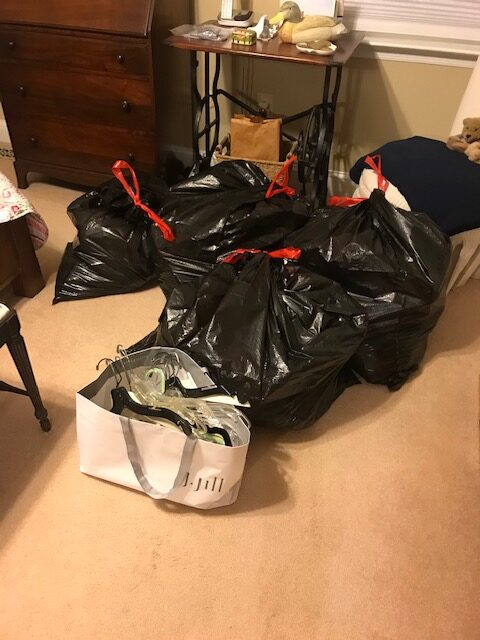
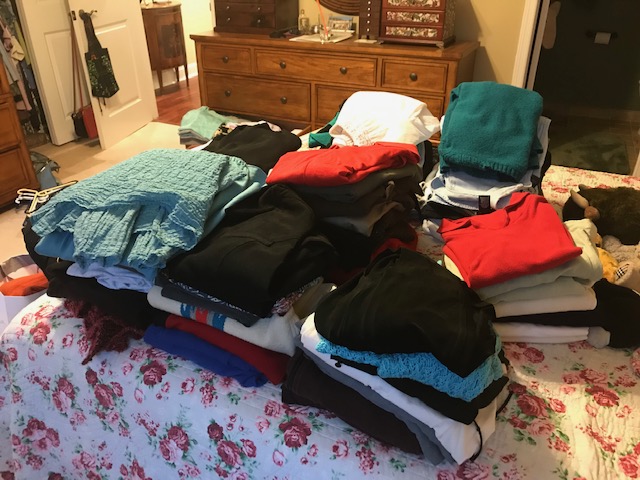
So, what does it say about a Professional Organizer asking for help from a Professional Organizer? Some of you may wonder why I couldn’t do this by myself.
Firstly, I was able to ask for help. There is nothing wrong with asking for help. We all have strengths, and we all face challenges in our lives. Why not ask for help when needed?
Secondly, what I experienced is exactly what my clients experience, and that was worth its weight in gold. I think I’m a pretty empathetic person, but this solidified it for me. I tried on clothes that I wasn’t sure about, and since my colleague was not emotionally invested in anything (but my parents bought that blouse in Greece for me a zillion years ago) and only had my best interest at heart, I was able to let go of mostly everything. I was bound and determined to get through the closets.
Thirdly, I had a stake in the game. The date was set, and I knew that since I was paying for the service, I was very prepared and determined to get through this project in a timely manner. I compared this to having a personal trainer. Once you pay for something, aren’t you more apt to follow through?
The funny thing about this is after the 4 hours, my colleague asked me if I was going to go through any of the clothes and pull things out that I think I may still want to keep. I laughed, said no, and realized I ask the same question to my clients.
Just because you have room for things, like I did, doesn’t mean you have to keep them, especially if you aren’t using them anymore. Perhaps the time is right for you to ask for help with your organizing projects.
People hire organizers because they feel their lives are out of control and they are unable to get organized on their own. Frequently the problem is simply having too much stuff to organize. Often the weight of too many possessions can wear us down. When our space is cluttered and dis-organized it can impact every facet of our lives.
When the burden of too much clutter is lifted from our shoulders, we can feel physically lighter, more energetic and less stressed. This relief can lead to increased work productivity, greater enthusiasm and better relationships.
The question we need to ponder is why do we purchase so much in the first place? There are a number of explanations for this compulsion. Often, we simply want to possess the latest and greatest stuff because we think it’s fun to own! We live in a consumer culture and we often validate ourselves by what and how much we can accumulate. Consumerism and materialism are promoted by advertisers in print and on TV and computers in the form of commercials. According to Annie Leonard who wrote, “The Story of Stuff”, the two main activities Americans engage in are watching TV and shopping. We are bombarded by advertising and are exposed to approximately 3,000 ads per day. We see more ads in a day then people saw in a year 50 years ago. Couple that with the fact that the average house size has doubled since the 1970’s and it becomes easy to see why we accumulate so much “stuff”.
Sadly, in order to maintain our lifestyles of consumption, many people are working 50+ hours per week. We work until we are exhausted and depleted and then we shop to make us feel better. We return home too tired to do much else than watch TV and the cycle begins anew!
Is this the way we really want to lead our lives? If so, fine. If not, then it’s time to rethink our goals and blithely step off that hamster wheel of consumption and examine saner options.

As an organizer, I always follow my client’s lead and only suggest we work on areas THEY identify. Every once in a while, though, I notice an irritating situation that could easily be solved with a label.
This scenario came up a month ago while working in someone’s dressing area: her space has a number of zones with specific task lighting tied to a central panel.
As we were leaving the space, she went to turn off her make-up area light. Not knowing which switch controlled which light, she ended up flicking every switch, one by one, until she found the ONE she needed. Her heavy sigh told me this issue is chronic.
So we fixed her problem — right then and there.
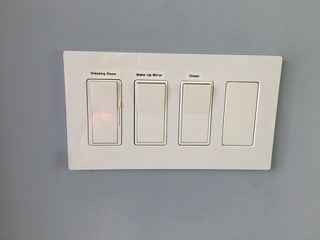
Now, if you know the story of the cobbler whose kids went barefoot, you will understand that just because I see “problem areas” in other people’s homes all day, this does not guarantee that I am a ruthless problem-solver in my own home.
Spoiler alert: not every shelf, bin or basket in my home is labeled!
Truth is, not every shelf, basket or bin NEEDS to be labeled. If it is obvious what it is and if no one is having an issue finding what they need, then there is no problem. But confusion breeds stress.
That same day, I went home and noticed myself doing the same thing to two of our three kitchen switches. That’s when I decided to do for myself what I do for others! So I labeled our switchplate. It’s been a game changer. The only thing I had to tweak was what I called them; my daughter did not think “door” made sense so we revised the label and now everyone is happy.
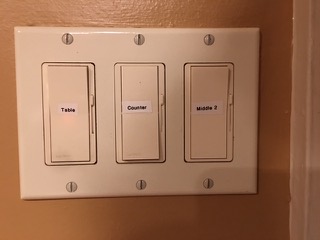
Our kitchen is the hub of our home, but now that the weather is warmer, we are spending a lot more time on our front porch.
Fast forward to the other day, when my husband texted me to make sure I turned off the front pathway lights. Our guests had stayed late the night before, and he didn’t want to waste electricity. In the daylight, I could not see if the lights were on or off… Couple that confusion with another multi-switch panel, and my stress level was rising. Without a partner to check the outdoor fixture’s bulb, it was more exercise than I expected so early in the morning. I figured it out on my own, turned the pathway lights off and did what any organized person would do: I labeled each switch.
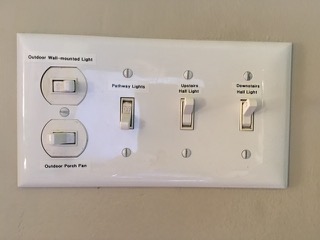
This time, my family approved of every label AND my daughter commented the next morning how helpful it was to know which switch controlled which hallway light. She had stayed up later than all — not unusual for teenagers — and knowing that we sleep with our door open at night to give our dog freedom, she didn’t want to wake us with a bright light at the top of the stairs.
My labels helped protect my investment of time, saved our daughter from waking us, and granted me an uninterrupted night’s sleep!
Think of where a label or two could help your household function a little better or brighter, or maybe even ensure a better night’s sleep for you.
Banish household confusion with a label or two; it’s illuminating!

The answer is …. Sort of.
I don’t necessarily wear the EXACT SAME THING EVERY DAY, but yes, I have about 4-5 outfits that I wear ALL THE TIME.
Why do I do that?
As a business owner, mom and CFO and COO (and housekeeper and launderer …) of our household, I’ve got A LOT TO DO. So the last thing I want to waste my energy on is figuring out what the heck to wear.
So, my general formula is:
And that’s about it. There’s no magic formula. There’s no exact number of items. There are no rules.
Here’s a few things to try:
Pare it down
When you are at a stage in life where you’ve just got TOO MUCH TO DO, then DO LESS. Channel your inner Steve Jobs (black tee and jeans!), make one less decision, and kick your morning off right.